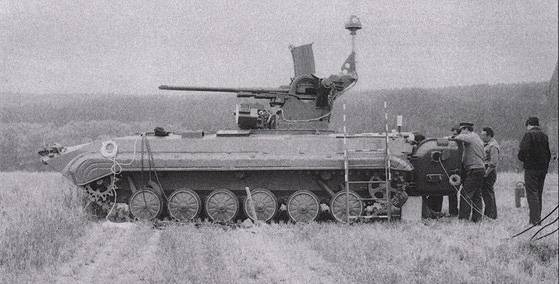来源:http://ftr.wot-news.com/2014/06/17/project-strop/
Hello everyone,
基佬们大家好
today, we’re going to have a look at another Czechoslovak post-war project, although this time, it’s from the 80′s. It was developed under the code name of STROP (“ceiling”).
今天我们去看看另一种捷克斯洛伐克战后装备,在80年代这绝对算的上先进,它的代号是STROP

By the time the idea that the Czechoslovak army should get a new AA vehicle was mentioned in the 70′s, the army was still equipped with the legendary vz.53/59 twin 30mm self-propelled AA autocannon on Praga chassis, also known as “Ještěrka” (lizard) – why was it legendary? This vehicle was extremely rugged and found its way all across the globe. This wheeled SP-AA vehicle did however some notable flaws, that were relevant to the Czechoslovak army. For starters, it could be operated in areas affected by WMD’s.. Its targetting system could not be connected to the effective command structure to the army and the gunner of the vehicle is practically exposed to shell fragments and small arms fire.
70年代捷克斯洛伐克陆军提出他们需要一种新的自行防空炮,当时他们还装备着传奇的 M53/59“普拉加”双联装30mm自行高炮,底盘为普拉加Ještěrka“蜥蜴”六轮装甲汽车。
这辆车传奇的原因是极其坚固,可穿越任何地形。这种轮式自行防空炮有明显的缺点,这也是与捷克斯洛伐克军方有关,首先,它可以在大规模杀伤性武器影响区域内运行,但其瞄准系统无法有效的与指挥系统连接,炮手会暴露在弹片和轻武器火力下。
And thus an idea was born to provide the army with something more effective in the AA role. However, the research was complicated, took time and so it was only in 1981 when it was finally decided to properly modernize the aging “Ještěrka” AA vehicle. The development was further complicated by the fact that the at that point, indigenous AA autocannons were not being developed for quite some time and that the electronics industry was not properly developed either.
就有了一种给军队提供一种更有效的自行防空炮的想法。然而研究是复杂的,需要时间,直到1981年才决定将“蜥蜴”自行防空炮现代化。这个发展将使武器系统进一步复杂化在当时的时间点。本土化的防空炮在电子工业没有适当的发展之前的相当一段时间是未被开发的。

In the end, the task to create a new AA vehicle was given to the Research Institute 010, specifically its 01 Department in Slavičín, in the cooperation with Research Institute 060 in Vyškov and other 010 departments. The project recieved a code name “STROP”. The task for these institutes from 1982 was “to propose a modern AA system, that can be manufactured from parts provided by Czechoslovak industry only and by the end of 1984 to build and trial a prototype”.
最后,设计新的自行防空炮的任务交给了010研究所。特别是斯拉维钦的01部门。在与维什科夫的060研究所以及其他10个部门的合作下,这个项目获得了一个代号“STROP”(滑索).这些研究院在1982年的任务是提出一种现代高射炮系统。必须采用捷克斯洛伐克所产零件并在1984年底制造并实验原型车。
The demands from the army were following:
军方需求如下:
– to passively find targets moving with speeds up to 300 m/s at the distance of 15-20km
– to identify targets at at least 10km distance
– to accurately aim in order to fire at at least 4km distance
– to be able to fire on both ground stationary and ground moving targets
可以被动发现15-20KM外以300M/S飞行的目标
在至少10KM的距离上识别目标
在4KM距离上准确的射击目标
能够对地面固定和地面移动目标开火
The vehicle was to consist of:
– a lightly armored chassis, based on a modified BMP-1
– a turret system, consisting of two turret parts linked together, autocannons, targetting systems and servo drives
– fire control system for the operator
– primary power sources, such as batteries and a generator
车辆底盘要求
一种轻装甲底盘,基于改进型BMP-1装甲车
炮塔系统:双联装炮塔,包括机关炮,瞄准系统,伺服驱动装置
操作员操作的火控系统
主电源系统,由电池和发电机组成
The prototype of the vehicle was based on a regular BMP-1 with a turret removed. The hull was somewhat modified as well. The relatively bulky fire control system was inserted inside the vehicle compartment. BMP-1 was chosen as a platform because it was readily available, it did fit the criteria required (WMD protection) and the army had experience with it already. Following changes were made to the hull:
原型车基于一辆拆除炮塔的BMP-1步兵战车。车体已经现代化改进。体积较大的火控系统被置入车体。选用BMP-1作为平台因为它是确实可用的,可防护大规模杀伤性武器,并且捷克斯洛伐克军队已经有了使用BMP-1的经验。对车体进行了如下修改:
– removed all the equipment inside the squad compartment, such as air filters and periscopes, the holes after them were covered
– removed the smoke generator and the middle fuel tank, reducing the fuel capacity from 460 to 120 liters
– moved the vehicle batteries to the squad compartment
– removed the commander vision devices, his seat and other communication equipment
– strenghtening the hull of the vehicle by welding an additional “skeleton” on it for improved structural integrity
– installing a turret ring from the T-55 tank
移除车厢内设备,例如潜望镜和通风孔,这些空洞将被覆盖
去除烟雾发生器与中间燃料箱,燃料容量从460减少到120升
-将电池移动到载员舱
-移除指挥官潜望镜,他的座位和其他通讯设备
-在车体内加装加强筋
安装T-55坦克的炮塔环
Driver’s compartment was not changed. The prototype turret was practically the same as on the “Ještěrka”. The cannons (30mm) were practically unmodified, although in the future, it was proposed to replace them with something new. The manual fire controls of the original system were removed and new, automatized fire control system was attached to the turret. The system was extremely complicated and required a lot of trials. All in all, over 400 trials were performed. In the end, the parameters of the guns remained the same as on the earlier “Ještěrka” design (the guns were not modified, because it was decided they would be eventually replaced anyway).
驾驶舱没有改变。原型车炮塔和”蜥蜴“自行防空炮很相似。30mm机炮不变,但是一些系统被更新的所取代,例如手动灭火装置被拆除,取而代之的是连接到炮塔上的自动灭火系统。该系统是非常复杂的,需要大量的试验。总共进行了400多次测试。最终,火炮的参数和”蜥蜴“早期设计相同。(火炮未被改进,因为它最终被决定用其他火炮取代)
The gun turret could traverse to 180 degrees to each side. The turret could turn as fast as 100 degrees per second in traverse (and 60 degrees per second in elevation). The maximum range of the TV targetting device and the range finder was 7 kilometers (under ideal conditions, it was possible to track a MiG 21 at 11 kilometers though). It was possible to start firing after 6 seconds from the point of target acquisition. The maximum firing distance was 4000m on target closing towards you, the effective firing distance was 1500-2000 meters.
炮塔可以向每侧旋转180度。炮塔可以以每秒钟100度的速度旋转(以60度每秒的速度调节俯仰角)电视瞄准系统和测距仪最大工作范围为7KM(理想状态下,这套系统能够跟踪11KM外的MIG-21)。目标锁定到开火时间为6秒。对直接对着防空炮飞来的目标可以从4000m外开始射击,有效射击距离为1500-2000米。
First trials took place in 1984, more trials a year later. In the end however it was found that the BMP-1 with 6 roadwheels does not have sufficient carrying capability – a prolonged chassis with 7 roadwheels would have to be created, or the vehicle would have to be moved to a platform with wheels. And so, the prototype did not fulfill the expectations, but the experience served the developers well in the future. Project STROP was cancelled, but later on, another project – STROP II – was concieved, this time on a wheeled T815 truck chassis.
第一次实验在1984年举行,这一年经过了更多的实验。到头来却发现有6个负重轮的BMP-1不具有足够的承载能力–一个拥有7个负重轮的加长底盘将被制造,或者这套系统将被转移到轮式平台。因此,原型不符合预期,但这辆车给了制造者宝贵的经验。STROP工程被取消,但后来,STROP II工程基于轮式T815卡车底盘被构思。
Weight: 15,17 tons
Length: 6,74m
Width: 2,94m
Height: 3,575m (combat position), 2,7m (travelling position)
重量:15,17吨
长度:6.74m
宽度:2.94m
高度:3.575M(战斗状态),2.7m(行军状态)
Gun: twin 30mm Vz.53/59, -8/+80 elevation, 180 degrees traverse, 420-450 rounds per minute (per one gun), 50 rounds in a feeder
武装:双联30MM Vz.53/59机炮,俯仰角-8到+80度,左右射界各180度,单管每分钟420-450发,一个弹匣50发

唷 新鲜人第一篇译作,鼓励一下。